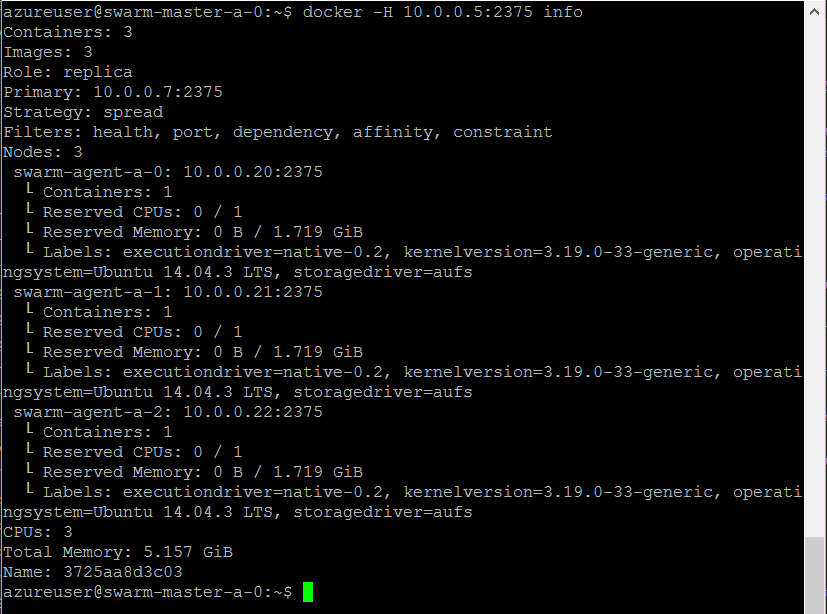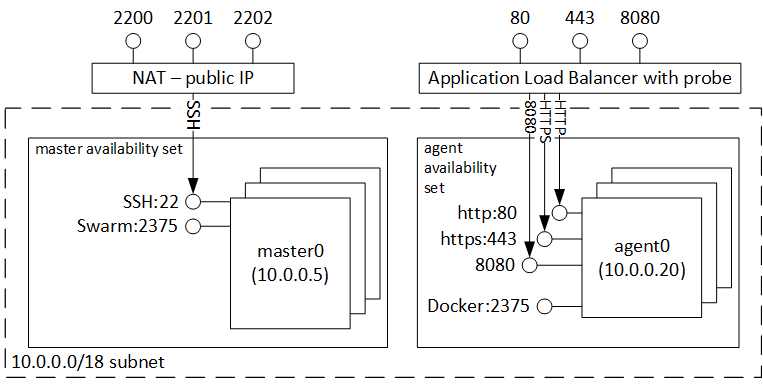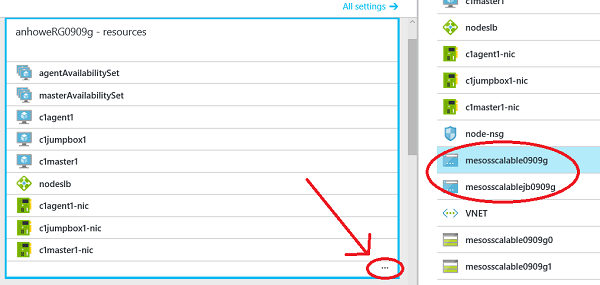These Microsoft Azure Stack templates create docker Swarm clusters.
The below content is to give overall architecture of the Swarm Cluster
Once your cluster has been created you will have a resource group containing 2 parts:
-
a set of 1,3,5 masters nodes. Each master's SSH can be accessed via the public dns address at ports 2200..2204
-
a set of agents nodes. The agent VMs must be accessed through the master.
The following image is an example of a cluster with 3 masters, and 3 agents:
All VMs are on the same private subnet, 10.0.0.0/18, and fully accessible to each other.
Follow the below links to create/download an Ubuntu 14.04 LTS Image and upload the same to Azure Stack's Platform Image Repository(PIR)
- https://azure.microsoft.com/en-us/documentation/articles/azure-stack-linux/
- https://azure.microsoft.com/en-us/documentation/articles/azure-stack-add-image-pir/ Note: please use the default values for linuxPublisher,linuxOffer,linuxSku,linuxVersion found in azuredeploy.json while creating the manifest.json in PIR
=> Deploy to azurestack, using custom deployment in azurestack portal. => or use Deployswarm.ps1 to deploy to azurestack via powershell.
-
Get your endpoints to cluster
-
browse to https://portal.azurestack.local
-
then click browse all, followed by "resource groups", and choose your resource group
- then expand your resources, and copy the dns names of your jumpbox (if chosen), and your NAT public ip addresses.
- Connect to your cluster using windows jumpbox - remote desktop to the windows jumpbox
- After successfully deploying the template write down the two output master and agent FQDNs.
- SSH to port 22 of the master private ip
- Type
docker -H 10.0.0.5:2375 infoto see the status of the agent nodes.
- Type
docker -H 10.0.0.5:2375 run hello-worldto see the hello-world test app run on one of the agents
- After successfully deploying the template write down the two output master and agent FQDNs.
- create the following docker-compose.yml file with the following content:
web:
image: "yeasy/simple-web"
ports:
- "80:80"
restart: "always"
- type
export DOCKER_HOST=10.0.0.5:2375so that docker-compose automatically hits the swarm endpoints - type
docker-compose up -dto create the simple web server. this will take about a minute to pull the image - once completed, type
docker psto see the running image.
- You can now scale the web application by typing
docker-compose scale web=3, and this will scale to the rest of your agents. The Azure load balancer will automatically pick up the new containers.
- This version of swarm is a non-HA(no Loadbalancer or Availabilitysets) with master, Agent node deployment.
- Refer https://help.ubuntu.com/community/SSH/OpenSSH/Keys#Generating_RSA_Keys for generating sshkeys for ubuntu
- the installation log for the linux jumpbox, masters, and agents are in /var/log/azure/cluster-bootstrap.log
- event though the VMs finish quickly configuring swarm can take 5-15 minutes to install, check /var/log/azure/cluster-bootstrap.log for the completion status.
This template deploys both the Custom Script and BGInfo VM Extensions to an existing Windows VM in an Azure Stack environment. It takes a parameter for vmName, and allows for the execution of a command (as seen in the commandToExecute Extension setting).






